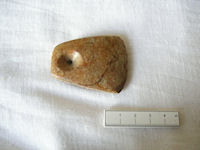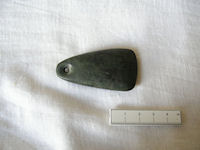PREVIOUS
NEXT
CONTENTS
HOME
4. Fragmentation and Reuse
Any surviving evidence for breakage, or reworking and reuse was also recorded in detail. Table 2 summarises this evidence for fragmentation and reuse. Harbison had noticed that many of the Irish bracers, about one-third in fact, were broken. Some had been re-bored as smaller bracers, and some of the broken pieces had also been reworked and probably used as pendants. In our Dublin sample we recorded an even higher incidence of breakage (61%) although a lower number of items had been re-bored as smaller bracers. We also found a much higher incidence of breaks that had been reworked and repolished (80% of the broken items).
Table 2: Irish bracers: breaks and reuse
| | Original analysis | Dublin new study |
|---|
| | Harbison 1976 | NMI 2006 |
|---|
| Total bracers | 100 | | 33 | |
| Broken | c. 33 | c. 33% | 20 | 61% |
| With new hole | 12 | 12% | 3 | 9% |
| With new hole as a % of broken items | | 36% | | 16% |
| With break reworked | 6 | 6% | 16 | 48% |
| With break reworked as a % of broken items | | 18% | | 80% |
Examples studied where half-bracers had been reworked at the broken end and supplied with a new perforation in order to produce a refurbished but shorter bracer included Harbison numbers 68, 76 and 79. Other broken bracers had not been re-bored, and the items survived as artefacts with a single perforation (Harbison numbers 3, 10, 12, 23, 27, 30, 32, 50, 59, 71 and 95). However, the broken ends have been smoothed and often repolished, and such pieces are most likely to have functioned as pendants.
It may be instructive, therefore, to look at the history of the use of pendants in European prehistory. Pendants of various materials were in fairly common use since at least Neolithic times. Examples in bone or ivory were found at Skara Brae (Clarke et al. 1985, fig. 3.28) and a selection of multi-coloured miniature pestle-shaped pendants have been found in some Neolithic tombs in Ireland such as Carrowkeel, Co. Sligo (Wallace and O'Floinn 2002, fig. 2:10). Similar stone pendants were also common in certain parts of Mediterranean Europe. In a study of small axe pendants from Italy, Malta, Sicily and Sardinia, Robin Skeates (1995) was able to show that most pendants were very finely finished and made from green stone (including serpentine, nephrite and jadeite). These date from the Middle Neolithic until the end of the Late Bronze Age, but most were deposited in the Early Bronze Age. Such pendants were probably cut down from pre-existing greenstone axe heads. They will have been very long-lived artefacts, with their own symbolic meanings and individual biographies. Such heirloom items may well have functioned as amulets, charms and votive objects. Their use may have involved a continuation of the special powers held by the original axes themselves and furthermore the miniaturisation may have expressed 'a compression or condensation of the meaning or cultural value of larger stone axes' (Skeates 1995, 288). Similar cut-down axe pendants are also known from Britain, including two unpublished Dorset items (from Preston and Wootton Fitzpaine), both of which are made from jadeite (Fig. 4).


Figure 4: Perforated axe head pendants from Dorset. a) (top) from Wootton Fitzpaine DORCM 1942.33.1, b) (lower) from Preston DORCM 1932.334 (© Dorset Natural History and Archaeological Society at the Dorset County Museum). Photographs by Peter Woodward.
The same phenomenon occurs in England and Scotland, although cut down or broken Beaker-age bracers are far less common than in Ireland. There are a few examples of small fragments, ends or corners from bracers, with one to three holes remaining. In each case some or all of the broken edges had been smoothed and reshaped and we believe that such items, some of them found in graves, may have functioned as pendants and amulets in the same way as the cut-down axe pendants (Woodward et al. in prep). And sometimes, as in Ireland, the bracer fragments were larger, comprising one-third, one-half or an even larger proportion of the original artefact. The pendant tradition of course reached its culmination in the 'Wessex Series' grave groups of the Early Bronze Age in Britain, with various examples made from exotic raw materials such as jet, amber, faience and gold.
Returning to the examples of reworked jasper bracer pendants from Ireland, it is of further interest to note that in a few cases we were able to observe evidence that the long original bracers had not been dropped accidentally, but may have been purposely snapped or sawn in half. For instance, some items showed evidence of sharp nicks on one side, and these appear to have been made with a tool, probably of metal. Turning to the English and Scottish corpus once again, we have noted a particular occurrence of 'significant halves', that is, bracers that seem to have been broken exactly across the centre (Woodward et al in prep.).
John Chapman has pointed out that fragments of important artefacts are often found as single fragments in closed deposits such as hoards, graves, pits or middens (Chapman and Gaydarska 2006). The other pieces are not present and the question therefore is: what happened to the other parts of these significant artefacts? Chapman's hypothesis is that many items were deliberately broken so that the pieces could be taken away by different people as a sign of their social engagement – and perhaps to be reunited at some future point in time. This forms his concept of social 'enchainment'. These ideas could equally be applied to the broken fragments of bracers that are found throughout the British Isles, and particularly in Ireland. Our aim of course is to find two bracer halves that fit each other, although so far we have not achieved this. However, the evidence of the long use-life of part-bracers as pendants or amulets does confirm the powerful social value of the 'bits and pieces'.
PREVIOUS
NEXT
CONTENTS
HOME
© Internet Archaeology/Author(s) URL: http://intarch.ac.uk/journal/issue26/31/4.html
Last updated: Wed Jul 29 2009

